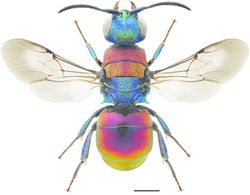Hedychrum niemelai\according to Paukkunen et al 2015
| Notice: | This page is derived from the original publication listed below, whose author(s) should always be credited. Further contributors may edit and improve the content of this page and, consequently, need to be credited as well (see page history). Any assessment of factual correctness requires a careful review of the original article as well as of subsequent contributions.
If you are uncertain whether your planned contribution is correct or not, we suggest that you use the associated discussion page instead of editing the page directly. This page should be cited as follows (rationale):
Citation formats to copy and paste
BibTeX: @article{Paukkunen2015ZooKeys, RIS/ Endnote: TY - JOUR Wikipedia/ Citizendium: <ref name="Paukkunen2015ZooKeys">{{Citation See also the citation download page at the journal. |
Ordo: Hymenoptera
Familia: Chrysididae
Genus: Hedychrum
Name
Hedychrum niemelai Linsenmaier, 1959 – Wikispecies link – Pensoft Profile
- Hedychrum aureicolle ssp. niemeläi Linsenmaier, 1959: 38.
- Hedychrum niemelai: Morgan 1984[1]: 8.
Diagnosis
Length 5–8 mm. The colouration is similar to Hedychrum nobile, but the pronotum and mesoscutum of the female are usually bright red (Fig. 53) and rarely yellowish. The mesotibial depression of the male is deeper than in Hedychrum nobile and oval or longitudinal in shape (Fig. 58). The tubercle on the posterior margin of S3 of the female is apically divided and smaller (Fig. 60) than in Hedychrum nobile. Additionally, the punctation of T3 is denser, especially in the male (Fig. 63).
Distribution
Denmark, Estonia, Finland, Latvia, Lithuania, Norway, Sweden. Common. – Trans-Palearctic: from Europe to China (Heilongjiang) (Rosa et al. 2014[2]).
Biology
Habitat: sparsely vegetated sandy areas. Adults are often found on flowers of Apiaceae, Asteraceae and Onagraceae (Rosa 2004[3], our own obs.). Flight period: from early June to late August. Host: Cerceris quadrifasciata (Panzer) and Cerceris quinquefasciata (Rossi) (Crabronidae) (Schmid-Egger et al. 1995[4], Saure 1998[5], our own obs.). Possibly also Cerceris arenaria (Linnaeus), Cerceris ruficornis (Fabricius) and Cerceris rybyensis (Linnaeus) (Lomholdt 1975[6], Morgan 1984[1]).
Taxon Treatment
- Paukkunen, J; Berg, A; Soon, V; Ødegaard, F; Rosa, P; 2015: An illustrated key to the cuckoo wasps (Hymenoptera, Chrysididae) of the Nordic and Baltic countries, with description of a new species ZooKeys, (548): 1-116. doi
Images
|
Other References
- ↑ 1.0 1.1 Morgan D (1984) Cuckoo-wasps, Hymenoptera, Chrysididae. Handbooks for the Identification of British Insects, Vol. 6, Part 5. Royal Entomological Society of London, London, 37 pp.
- ↑ Rosa P, Wei N, Xu Z (2014) An annotated checklist of the chrysidid wasps (Hymenoptera, Chrysididae) from China. ZooKeys 455: 1–128. doi: 10.3897/zookeys.455.6557
- ↑ Rosa P (2004) Alcune osservazioni sulle relazioni tra Vegetazione e Crisidi (Hymenoptera, Chrysididae) in Italia. Giornale Italiano di Entomologia 11: 79–90.
- ↑ Schmid-Egger C, Risch S, Niehuis O (1995) Die Wildbienen und Wespen von Rheinland-Pfalz (Hymenoptera, Aculeata) – Verbreitung, Ökologie und Gefährdungssituation. Fauna und Flora in Rheinland-Pfalz, Beiheft 16: 1–296.
- ↑ Saure C (1998) Beobachtungen und Anmerkungen zur Wirtsbindung einiger Goldwespenarten im nordostdeutschen Raum (Hymenoptera: Chrysidididae: Chrysidinae). Bembix 10: 15–18.
- ↑ Lomholdt O (1975–1976) The Sphecidae (Hymenoptera) of Fennoscandia and Denmark. Fauna Entomologica Scandinavica 4: 1–452.

